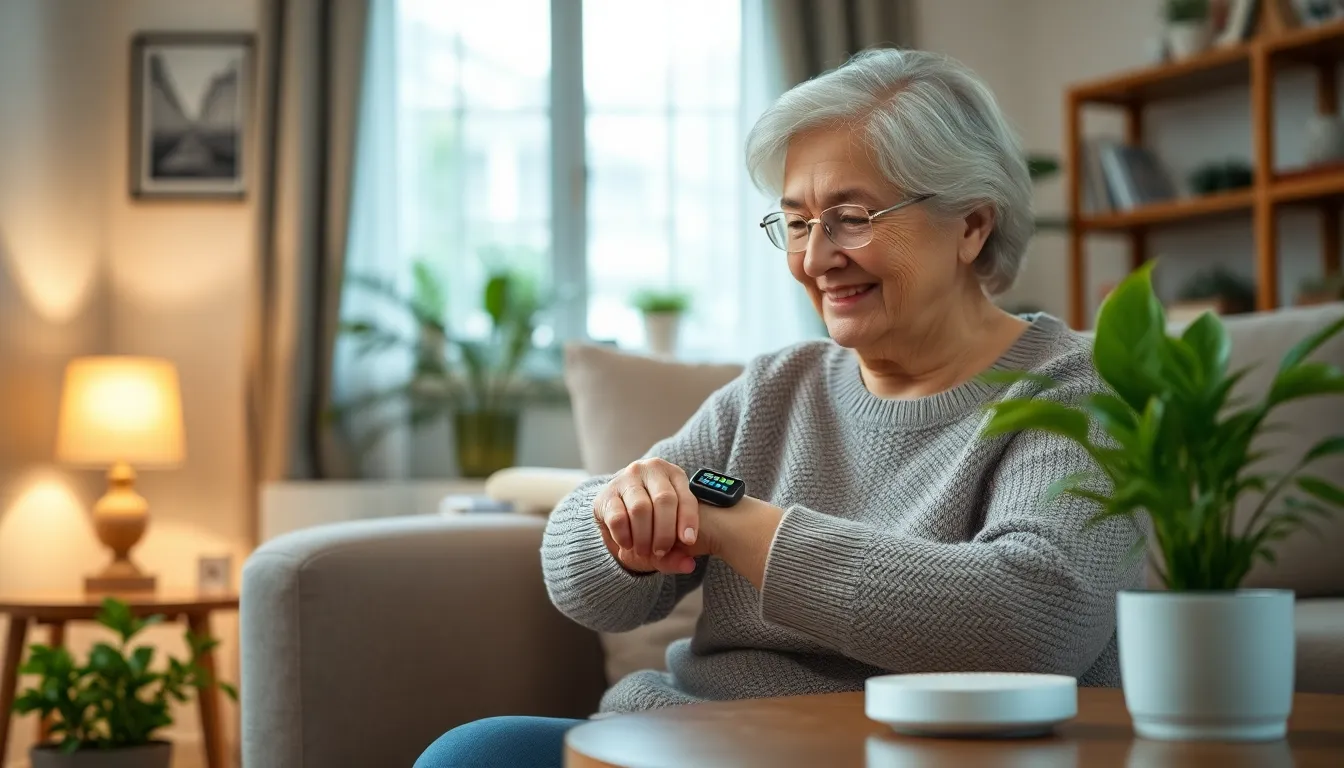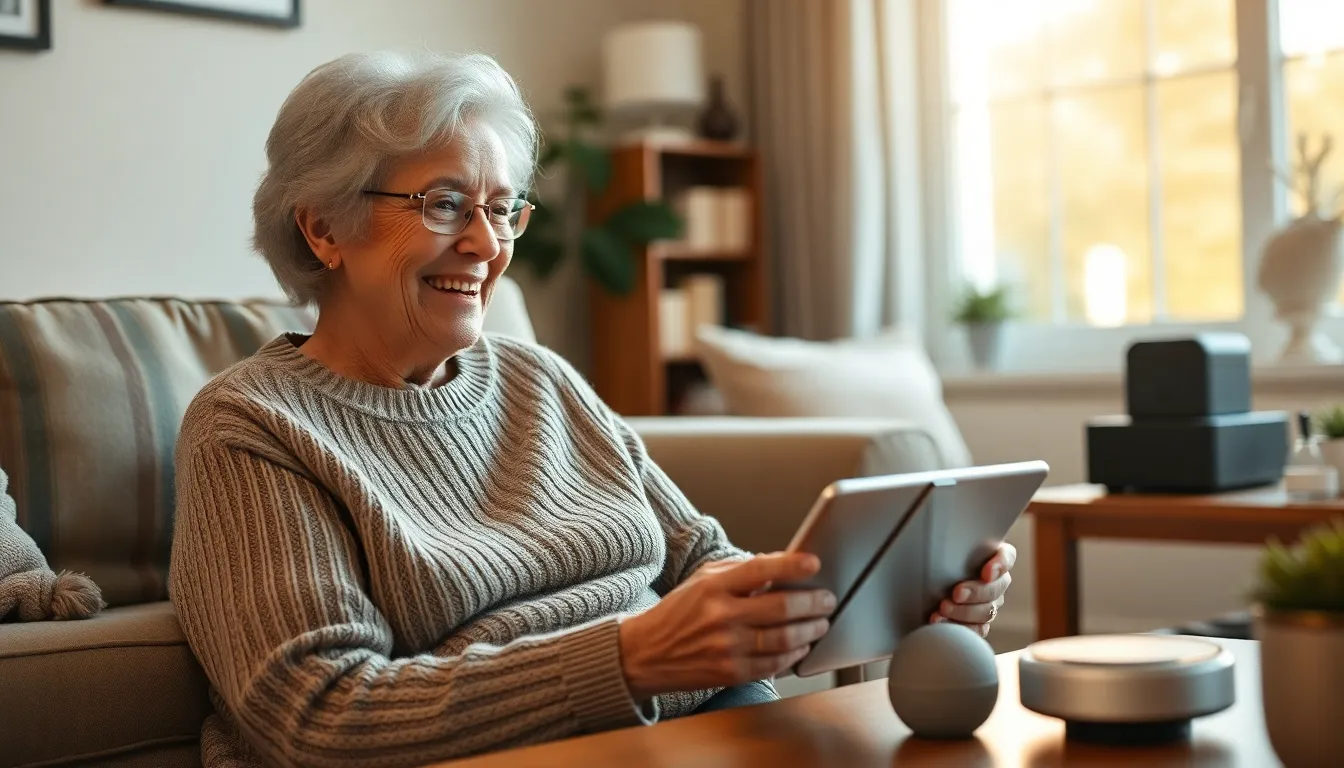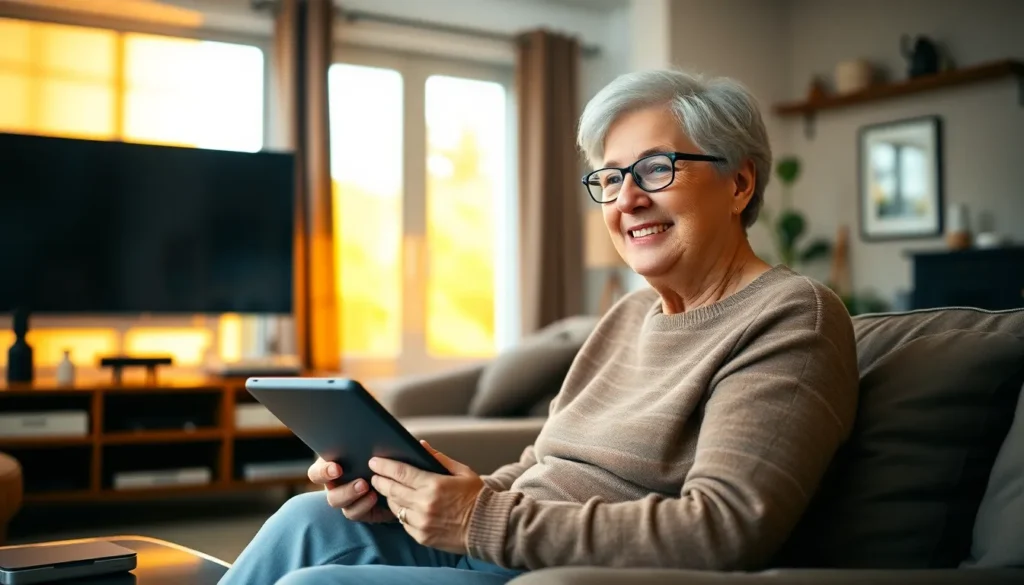As the population ages, the quest for innovative solutions in elder care becomes more crucial. Enter the Internet of Things (IoT)—a tech-savvy superhero ready to swoop in and save the day. Imagine smart devices that not only remind Grandma to take her meds but also alert family members when she’s taken an unexpected detour to the kitchen for a midnight snack.
With IoT, elder care transforms from a daunting task into a seamless experience. These connected devices don’t just boost safety; they also sprinkle a bit of joy into daily routines. From wearable health monitors to smart home systems, the possibilities are endless. It’s time to embrace technology that keeps our loved ones safe while allowing them to maintain their independence. After all, who wouldn’t want a little extra help in their golden years—especially if it comes with a side of humor?
Table of Contents
ToggleOverview of IoT for Elder Care
IoT technology increasingly shapes elder care, enhancing comfort and safety for seniors. Smart devices serve various purposes, from medication reminders to daily activity monitoring. These tools promote independence by allowing elderly individuals to age in place securely. Wearable health monitors track vital signs like heart rate and blood pressure, providing crucial data for caregivers and family members.
Remote access to health information stands as one of the strongest advantages. Family members can receive real-time notifications about their loved one’s health status. Smart home systems, equipped with sensors for emergency alerts, ensure immediate responses during falls or other incidents. Adaptive lighting and temperature controls also create a more comfortable living environment.
Many applications target specific needs. GPS trackers help seniors navigate their surroundings, reducing the risk of getting lost. Fall detection systems can alert caregivers instantly if an elderly person requires assistance. Communication tools foster connections, allowing older adults to stay in touch with family, easing feelings of isolation.
The integration of IoT in elder care represents a shift towards proactive health management. Better access to data allows caregivers to make informed decisions. This technology doesn’t merely respond to issues; it anticipates them. As a result, seniors experience improved quality of life while maintaining autonomy.
Elder care organizations increasingly adopt these innovative solutions, recognizing their potential to enhance care. With ongoing advancements, the landscape of elder care continues to evolve, integrating technology that prioritizes safety and well-being. Embracing IoT supports aging populations while ensuring their families stay connected and informed.
Benefits of IoT in Elder Care

The integration of IoT significantly enhances elder care by improving safety and health management. It creates a supportive environment that addresses the unique needs of older adults.
Enhanced Monitoring and Safety
Smart devices facilitate continuous monitoring of seniors, ensuring their well-being. Wearable devices track vital signs, alerting caregivers to potential issues. Emergency alert systems immediately notify family members in case of falls or emergencies. GPS trackers provide valuable location data for seniors who may wander. Smart home systems, equipped with sensors, detect unusual activity, promoting a secure living space. Together, these technologies foster a safer, more connected environment for elderly individuals.
Improved Health Management
IoT technology streamlines health management for older adults by providing real-time data. Remote health monitoring enables caregivers to track health metrics efficiently. Automated medication dispensers ensure timely administration of prescriptions, reducing the risk of missed doses. Family members receive notifications about health changes, promoting informed decision-making. Telehealth services facilitate virtual consultations, allowing seniors access to medical professionals without travel. These advancements in health management empower older adults to maintain optimal wellness while aging in place.
Challenges of Implementing IoT for Elder Care
The integration of IoT in elder care faces several challenges. Addressing these issues is essential for maximizing the benefits of technology for seniors.
Privacy and Security Concerns
Elder care IoT devices collect vast amounts of sensitive data, raising significant privacy issues. Personal health information could be vulnerable to cyberattacks. Many seniors and their families worry about data breaches exposing critical health metrics. Implementing strong cybersecurity measures becomes crucial to ensure data integrity. Transparent data usage policies enhance trust, allowing families to feel secure about their loved ones’ information. Additionally, educating seniors on navigating privacy settings and recognizing potential threats empowers them to protect their personal data.
Technology Adoption Among Seniors
Many seniors face hurdles in adopting new technologies. Limited technical skills often create barriers to effectively using IoT devices. Older adults may feel overwhelmed by complex interfaces or unfamiliar features, leading to frustration. Support and training significantly help ease this transition. Offering user-friendly devices designed specifically for older adults facilitates adoption. Encouraging family members and caregivers to assist seniors in learning new technologies also promotes confidence. Incorporating intuitive designs with clear instructions enhances the likelihood of successful implementation in their daily lives.
Innovative IoT Solutions for Elder Care
Smart home systems transform living spaces into supportive environments for seniors. These systems allow for real-time monitoring of health conditions and daily activities. Emergency alert sensors enhance safety by notifying caregivers immediately if a fall occurs or if assistance is needed. With the use of adaptive controls, seniors can manage their home settings easily, creating a comfortable atmosphere.
Wearable health monitors provide continuous tracking of vital signs such as heart rate and blood pressure. Data collected from these devices can be shared with healthcare providers, facilitating timely interventions. When an anomaly is detected, alerts can be sent to family members, ensuring quick response measures.
Telehealth services play a crucial role in modern elder care. Virtual consultations with medical professionals reduce the need for travel, saving time and effort for seniors. Regular check-ins through video calls keep healthcare access smooth, ensuring that seniors receive necessary assistance without leaving their homes.
GPS trackers safeguard seniors by providing location data, vital for those prone to wandering. Family members can utilize this technology to locate loved ones quickly, promoting peace of mind. These trackers often combine with mobile apps that allow for real-time updates, enhancing communication and connection.
Communication tools combat isolation among older adults. With user-friendly interfaces, these devices enable seniors to stay in touch with family and friends effortlessly. Regular interaction can significantly lift spirits, contributing to overall mental well-being.
Privacy and security concerns are essential in implementing these IoT solutions. Data protection measures should be prioritized to keep sensitive information safe from breaches. Educating seniors on using these systems can ease their hesitant adoption, allowing them to benefit fully from technological advancements.
Future Trends in IoT for Elder Care
Enhanced connectivity emerges as a central theme in IoT for elder care, facilitating better communication between devices. Smart home technology evolves, integrating more seamlessly with daily activities. Voice-activated assistants gain traction, helping seniors manage tasks through simple commands. These devices foster independence, allowing older adults to maintain autonomy while receiving necessary support.
Telehealth services expand, offering virtual check-ups and consultations directly from home. Remote patient monitoring becomes commonplace, capturing vital health statistics in real time. Family members receive instant updates, ensuring they stay engaged with their loved one’s wellbeing. AI-powered analytics improve, allowing caregivers to identify patterns and respond proactively to health issues.
Wearable technology advances, providing seniors with stylish and functional health monitors. These devices track fitness levels, sleep patterns, and even heart rates, promoting overall health awareness. Specialist healthcare providers utilize the data collected by wearables to enhance personalized care strategies. Fall detection and emergency alert systems become increasingly sophisticated, significantly reducing response times.
Smart appliances continue to evolve, optimizing energy use and maintaining safety. For example, refrigerators can alert users when food expiration dates approach, while ovens can communicate safety parameters to prevent accidents. IoT-enabled security systems not only enhance safety but also give families peace of mind regarding their loved ones’ environments.
Addressing privacy and security remains a top priority with these technological advances. Companies focus on implementing stronger cybersecurity measures to safeguard sensitive data. Education becomes vital, equipping seniors with knowledge about device use and privacy settings. Simplifying interfaces encourages engagement, making it easier for older adults to embrace technology confidently.
The integration of IoT in elder care signifies a transformative era for seniors and their families. By leveraging smart technology, caregivers can enhance the safety, comfort, and independence of elderly individuals. This innovation not only streamlines daily routines but also fosters meaningful connections between seniors and their loved ones.
As the landscape of elder care evolves, embracing IoT solutions becomes essential for promoting proactive health management. Addressing challenges such as privacy and usability will be crucial in ensuring widespread adoption. Ultimately, the future of elder care lies in harnessing technology to improve quality of life while empowering seniors to maintain their autonomy.





